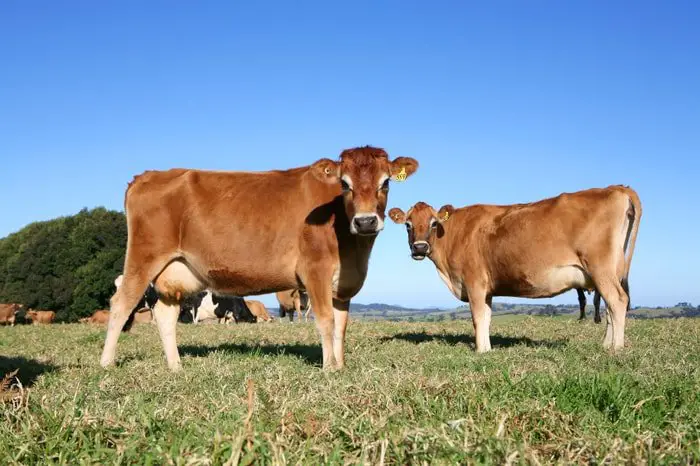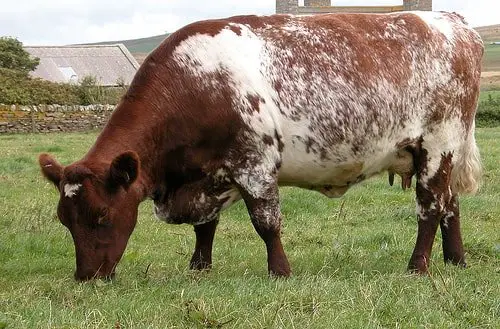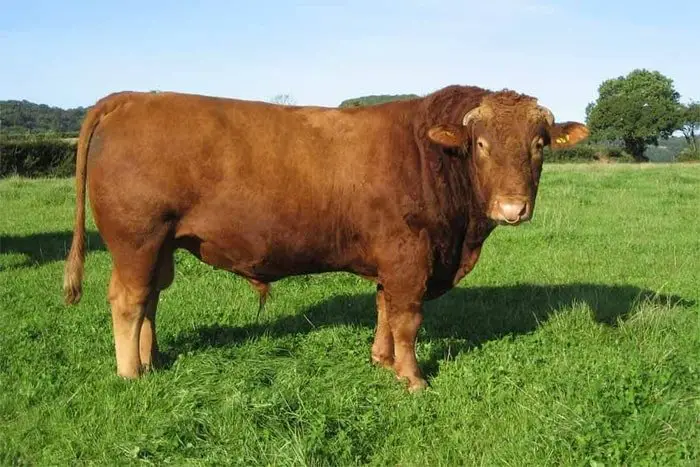Bovine Tuberculosis is an infectious disease caused by individual pathogenic acid-fast organisms of the genus Mycobacterium. It is usually characterized by the progressive development of nodular granulomas known as tubercles in any of the organs in most species. Although commonly defined as a chronic, wasting disease, TB occasionally assumes an acute, rapidly progressive course. The disease has zoonotic importance and transmits to the human beings by ingestion of infected cow’s raw milk and direct contact with infected animals.
Most Important Information on Bovine TB
Bovine Tuberculosis is the most common disease of cattle and other farm animals. The disease is distributed worldwide and reported more than 180 countries and regions of the world. Tuberculosis in cattle has great economic importance related to dairy farming, beef farming, cattle trade, transportation, exporting beef, milk, and milk products. The disease is also known as wasting disease, and the health of your cattle will deteriorate progressively. Moreover, the infection will spread to other healthy animals by direct and indirect contact. As a farm owner, you may be affected by your farm if the infection goes unnoticed. In my article, I shall discuss all possible information on Bovine TB for your easy understanding.

Causes of the Bovine TB
Tuberculosis in cattle is caused by the acid-fast bacillus of the Mycobacterium bovis. The organism belongs to the acid-fast group, which means that once the organism has been stained dye, it resists decolorization, even with strong mineral acids. Staining by the method of “Ziehl-Neelsen,” i.e., staining with warm carbon-fuchsin HCl in 95% alcohol and counter-staining with methylene blue.
Epidemiology of Tuberculosis in Cattle
Bovine Tuberculosis is known to exist in all parts of the world. Cattle are susceptible to human type tuberculosis, but lesions of this infection are seldom reported. Zebu cattle are less susceptible than exotic cattle. The organism affects humans, cattle, buffalo, sheep, goats, pigs, birds, monkeys, and zoo animals. The disease has significant zoonotic importance. The organism spread through various ways to animals to humans and animals to animals.

How is Bovine Tuberculosis Transmitted?
Tuberculosis organisms present in the various locations of the dairy farm, environment, utensils, and farm products. The tuberculous animal is the most significant source of danger to healthy animals. Organisms are excreted from infected animals in the:
- Exhaled air.
- Sputum.
- Feces ( from both intestinal lesions and swallowed sputum from pulmonary lesions).
- Milk.
- Urine.
- Vaginal and uterine discharges and.
- Discharges from open peripheral lymph nodes.
Bovine TB organism Commonly enters to susceptible host (Cattle, sheep, goat, horse) by various means:
- Inhalation in closed cattle due to close space, overcrowding leads to transmission.
- Ingestion, when infected feces contaminated with feed and water.
- Calves sometimes are infected during the first few hours or days of life when nursing by an infected dam.
- Calves may infrequently be infected as a result of intrauterine exposure.
- Coitus, infected germ cells, intramammary infection by the use of contaminated teat siphons.
- Humen beings get an infection from the drinking of infected raw milk or close contact with infected animals.
Pathogenesis of Tuberculosis in Cattle
The progressive development of the disease is called pathogenesis. As a farm owner, the pathogenesis knowledge will help you to diagnose, treat, and prevent Bovine TB early.
- Once tubercle bacilli have entered the tissues, they initiate a tuberculous lesion, either locally or in the adjacent lymph nodes.
- When the infection by inhalation, the lesion will be at the respiratory tract and adjacent lymph nodes.
- When the infection occurs via the digestive tract, the lesion will be in tonsillar and intestinal ulcers may occur.
- Whenever the organisms localize, their activity stimulates the formation of tumor-like masses called tubercles.
- Anybody tissue can be affected, but lesions are most frequently observed in lymph nodes (bronchial, mediastinal, portal, and cervical), lungs, liver, spleen, and surfaces of the body cavities.
How is Tubercle Established?
When tubercle bacilli enter the body, they usually are phagocytized by neutrophils almost immediately. The neutrophils are destroyed by multiplying mycobacteria, and dead cells stimulate the accumulation of epithelioid cells that engulf the neutrophils and mycobacteria. The bacilli are not destroyed but multiply with the epithelioid cells and produce toxic substances that destroy adjoining cells. This causes an area of caseous necrosis and the beginning of a tubercle.

More epithelioid cells encircle the necrotic area, while in the center of the tubercle, the cellular nuclei disappear, and structural detail is lost. Several epithelioid cells coalesce, forming multinucleated giant cells (Langhan’s giant cells). These cells are characteristic but not pathognomic of tubercles. Because they are also found in granulomatous lesions of other chronic inflammatory diseases, acid-fast bacilli may be demonstrated throughout a lesion in epithelioid cells, in giant cells, and necrotic debris.
What are the Symptoms of Bovine Tuberculosis?
Characteristic signs are often lacking even in advanced stages of the disease in which many organs may be involved. However, the signs exhibited by your animal depend upon the extent and location of lesions.
- Emaciation, lethargy, weakness, lack of appetite, and a low-grade, fluctuating fever.
- The broncho-pneumonia of the respiratory form of the disease causes a chronic, intermittent, moist cough with following signs of dyspnea and tachypnea.
- The involvement of the digestive tract is manifested by intermittent diarrhea and constipation in some instances.
- In advanced cases, lymph nodes are frequently enlarged and may obstruct air passages, blood vessels, and the digestive tract.
- Lymph nodes of the head and neck may become visible, affected, and sometimes rupture and drain to the outside.
- Extreme malnutrition and acute respiratory distress may occur during the terminal stages.
- Lesions involving female genitalia may occur.
- Primary uterine infection may occur the following service by an infected bull or even by artificial insemination with contaminated sperm cells.
- The onset of the disease differs significantly, from a few months to years, and some animals may never reach a clinical stage.
Diagnosis of Bovine TB
Clinical evidence of Tuberculosis is usually lacking, and the field diagnosis of Tuberculosis can be made on history, clinical examination, and tuberculin test. History of cattle introduced from the endemic tuberculosis area or infected herd. Emaciation, progressive wasting of the animals, enlargement of lymph nodes, and coughing in advanced cases suggest clinical examination.
1. Tuberculin Test. Tuberculin, a concentrated sterile culture filtrate of tubercle bacilli grown on glycerinated beef broth, and more recently, on synthetic media, provides a means of detecting TB in animals.
- Animals affected with tuberculous are allergic to the tuberculin proteins and give characteristic delayed reactions when exposed to them.
- If tuberculin is deposited intradermally, a local reaction characterized by swelling and inflammation is induced in infected animals. The caudal fold is the preferred injection site for the intradermal tuberculin test, and the injection site is examined by observation and palpation 72 hours after injection.
- Nearly all countries of the world are now using a strain of Mycobacterium bovis for the preparation of mammalian tuberculin. Heat-concentrated synthetic media tuberculin is usually used in some countries, but most are now using a purified protein derivative (PPD) tuberculin at a protein concentration of 1 mg/ml.
- PPD tuberculins are preferable because they are easier to standardize, more stable and more specific
2. Single Intradermal (SID) Test. It is the first test for the diagnosis of TB in your live animals. Tuberculin PPD ( 1mg/ml) 0.1 ml is injected into a site of the caudal fold or the mid-neck. The site is first clipped and examined to be free from evident lesions. The skin fold is measured with slide calipers twice (before and 72 hours after injection). A positive result is judged by an increase in the skinfold thickness of a least 5 mm. In suspicious cases, the test should be repeated one more time after 60 days.
3. Short Thermal Test (STT). Intradermal tuberculin (4 ml) is injected subcutaneously into the neck of cattle with a rectal temperature of not more than 102 degrees F (39 degrees C) at the time of injection. If the temperature at 4,6 and 8 hours after injection rises above 40 degrees C (104 degrees F), the animal is classed as a positive reactor.
4. Stormont Test. It is similar to the single intradermal test in the neck with a site seven days later. Increased skin thickness of 5 mm or more, 24 hours after this second injection, is a positive result.
5. Comparative Test. Avian and mammalian tuberculin is injected simultaneously into two separate sites on the same side of the neck, 12 cm apart and one above the other. The test is read 72 hours later. The greater of the two reactions indicates that the organism responsible for the sensitization.
It is usual to use the single intradermal test as a routine procedure, though this test is not entirely accurate, and the following deficiencies may occur.
6. False-positive reactions of the Tuberculin Test. Animal sensitized to other mycobacterial allergens, and these are:
- Animals infected with human or avian Tuberculosis or with Johne’s disease.
- Skin tuberculosis also reacts to tuberculin, relatively non-pathogenic mycobacteria.
- Animal desensitized by tuberculin administration during the preceding 8 to 60 days.
- Old cattle
7. Other serological tests for diagnosis of Bovine TB are includes:
- Complete fixation test (CFT).
- Fluorescent antibody test (FAT).
- Agglutination test (AT).
- Precipitation test (PT).
- Haemagglutination (HA) test.
8. Necropsy findings and culture examination of M bovis.
Treatment for Bovine Tuberculosis
Treatment of bovine Tuberculosis has been attempted using drugs that have had some success in man, e.g., isoniazid, streptomycin, and para-aminosalicylic acid. The efficacy of the treatment is limited due to zoonotic risk, and the danger of encouraging drug resistance that the treatment of bovine Tuberculosis is not allowed. The typical treatment protocol in the initial days after diagnosis are:
- Treatment of TB in animals is not feasible.
- Valuable animals may be treated with Anti-tuberculosis drugs like Isonicotinic acid Hydrazine (INH) or Isoniazid (IND).
- IND therapy may have potential value in countries where tests and slaughter are not feasible.
- Infected and suspect cattle may be treated with INH at a dose of 20mg per kg body weight maximum of 12 gms daily for three months.
- Supportive treatment with antihistamines, bronchodilators, and vitamin and mineral supplements with feed.
Prevention and Control of Bovine Tuberculosis
The prevention and control of Bovine TB are challenging. The control strategy follows three main paths. The total eradication of the population is not feasible in many countries. The standard and effective control measures of TB in cattle are as follows:
1. Test and Slaughter
- Eradication of bovine Tuberculosis is a significant objective that has nearly been achieved in many countries of Europe, united states, Japan, New Zealand, and Australia
- These eradication programs have been the systematic application of the tuberculin test and the slaughter of reactors.
2. Hygienic Measures
- You should isolate infected animals from healthy animals.
- Feed troughs should be cleaned and thoroughly disinfected with hot, 5% phenol, or equivalent cresol disinfected.
- Water throughs and drinking cup should not be fed to calves
- Farm attendant should be checked as they may provide a source of infection
- Movement of the animals should be restricted, whether movements are international interstate or local.
3. Vaccination of Bovine TB
- Since 1890 various vaccines have been advocated for cattle, but none has produced active immunity to bovine Tuberculosis.
- The use of BCG (Bacille Calmette Guerin) vaccine ( the most successful immunizing agent in humans) reduces the severity of the initial disease in cattle, but it does not entirely prevent infection. Besides affording no adequate protection to cattle, vaccination induces hypersensitivity to tuberculin and thus interferes with the diagnostic test.
Concluding Remarks on Bovine TB
Bovine Tuberculosis is one of the most economically significant diseases of dairy and beef farms. The disease will suffer you a low in many ways by reduction of production, deteriorating health, infected other animals, human, farm employees, and the consumers. Early diagnosis and treatment will help you to take adequate preventive measures for your farm. The identification of the affected animals and culling from the farm is the best way to prevent Tuberculosis in Cattle.